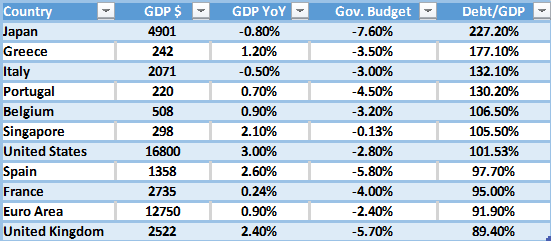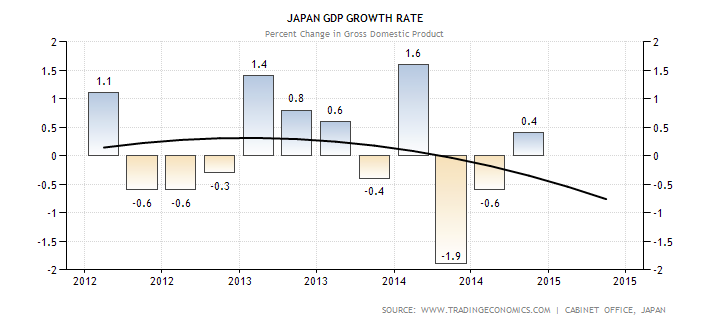Quantitative Easing or QE (the process through which a Central Bank prints money, with which to buy assets, in the hope of stimulating the economy) was first deployed in Japan. The unconventional monetary policy was meant to overcome decades of economic inertia since the “bubble economy” burst in the late eighties and early nineties. Subsequent rounds of QE have failed to move Japans economic situation forward and one could now argue that the expansion and continuation of the policy is starting to have a negative effect. Creating as it has a form of economic moral hazard for the Government of Shinzo Abe. I say that because the notion that the Bank of Japan would buy government debt has perhaps allowed the Abe Government to press ahead with its spending plans, which are funded through the issuance of debt, safe in the knowledge that this new debt would always find a home or a willing buyer.
Back stopped demand
Japanese Institutions are happy to take on Japanese debt in the knowledge that the BOJ is spending circa $60 billion per month on QE (bond buying) In fact the BOJ became the largest holder of JGBs or Japanese Government Bonds last June when its holdings rose above 20% of outstanding issues. Japanese institutions Banks, Insurers and government agencies hold another 57% or so.Foreign holders of Japanese bonds account for less than 9% of the outstanding issuance.
An Increasing debt burden
According to data compiled by Trading Economics Japans national debt, as a percentage of GDP has grown to a figure well head of any other major developed economy.As can be seen from the table below:

Stimulus is failing to deliver
Note as well that Japan is also running a larger budget deficit as percentage of GDP than its developed peers. Which alongside the negative annualised GDP figure suggests that the combination of fiscal stimulus (more government spending) and monetary stimulus (more BOJ printing and bond buying) are failing to achieve the economic recovery that the government is hoping for. After all if the economy was growing tax revenues should rise allowing the government to run a balanced budget, if not a budget surplus.Erratic economic performance
GDP is the measure that is used by economists to determine the state of play in an economy and to compare the performance of that economy against its own history and the performance of its peers.The chart below shows the quarterly performance of the Japanese economy since 2012 when the current administration came to power. Worryingly despite the considerable efforts of the government and the BOJ, the economy has not been able to produce four consecutive quarters of growth in this period and has seen as many negative quarter as positive ones. The black line on the chart is the forecasted direction of future Japanese GDP growth, as we can see this in negative territory.

Inflation remains low
Not only is GDP growth a cause for concern so is the level of inflation. Inflation is often thought of as a bad thing in an economy if and when its gets out of control however inflation at moderate levels can actually be seen as a barometer for a healthy economy within which demand is leading supply.Japan in common with the UK and the Eurozone has an official inflation target of 2% but as with those economies the underlying rates of inflation are well below target.
Falling prices are of course common too many developed economies at the current time. But given the massive depreciation in the yen against the dollar, >50% since the autumn of 2012. One might have expected to see prices rise dramatically especially as during this period Japan became reliant on energy imports to replace power previously generated by its nuclear plants which went offline in the wake of the Fukishima disaster.
Recommended Content
Editors’ Picks
USD/JPY holds above 155.50 ahead of BoJ policy announcement

USD/JPY is trading tightly above 155.50, off multi-year highs ahead of the BoJ policy announcement. The Yen draws support from higher Japanese bond yields even as the Tokyo CPI inflation cooled more than expected.
AUD/USD extends gains toward 0.6550 after Australian PPI data

AUD/USD is extending gains toward 0.6550 in Asian trading on Friday. The pair capitalizes on an annual increase in Australian PPI data. Meanwhile, a softer US Dollar and improving market mood also underpin the Aussie ahead of the US PCE inflation data.
Gold price keeps its range around $2,330, awaits US PCE data

Gold price is consolidating Thursday's rebound early Friday. Gold price jumped after US GDP figures for the first quarter of 2024 missed estimates, increasing speculation that the Fed could lower borrowing costs. Focus shifts to US PCE inflation on Friday.
Stripe looks to bring back crypto payments as stablecoin market cap hits all-time high

Stripe announced on Thursday that it would add support for USDC stablecoin, as the stablecoin market exploded in March, according to reports by Cryptocompare.
US economy: Slower growth with stronger inflation

The US Dollar strengthened, and stocks fell after statistical data from the US. The focus was on the preliminary estimate of GDP for the first quarter. Annualised quarterly growth came in at just 1.6%, down from the 2.5% and 3.4% previously forecast.